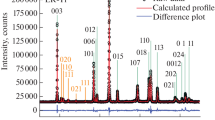Abstract
Nickel oxide electrodes that suffered capacity degradation during extended cycling in zinc/nickel oxide cells were examined by a variety of chemical and physical techniques. Nickel hydroxyzincates, which have been speculated to cause such capacity degradation, were also examined. Powder X-ray diffraction experiments indicated that the intersheet distance between layers of turbostratic nickel hydroxide increased when zinc was incorporated. Photoelectron spectra (XPS) showed that this material is probably a mixture of NiOH)2 and ZnO or Zn(OH)2. Raman spectroscopy data also supported this conclusion. XPS indicated that the form of zinc in degraded nickel oxide electrodes is probably ZnO or Zn(OH)2. Significant increases in resistivity were found in cycled nickel oxide electrodes, and optical microscopy provided visible evidence of mechanical damage during cycling. These results suggest that the observed capacity degradation was largely mechanical in nature, and not due to the formation of nickel-zinc double hydroxides, as had been reported by others. Cell-cycling experiments indicated that the mechanical degradation is largely irreversible.
Similar content being viewed by others
References
T. C. Adler, F. R. McLarnon and E. J. Cairns, J. Electrochem. Soc. 140 (1993) 289.
E. Buder, J. Appl. Electrochem. 2 (1972) 301.
I. Arulraj and D. C. Trivedi, Int. J. Hydrogen Energy 14 (1989) 893.
B. E. Conway, M. A. Sattar and D. Gilroy, Electrochim. Acta 25 (1980) 973.
G. Bronoel and J. Reby, ibid. 25 (1980) 973.
K. Kinoshita, ‘Electrochemical Oxygen Technology’, John Wiley & Sons, New York (1992).
D. H. Fritts, J. Power Sources 6 (1981) 327.
Idem, ibid., 12 (1984) 267.
O. Lanzi and U. Landau, J. Electrochem. Soc. 138 (1991) 2527.
M. Natan, D. Belanger, M. Carpenter and M. Wrighton, J. Phys. Chem. 91 (1987) 1834.
A. Briggs, J. Appl. Electrochem. 21 (1982) 999.
V. Dmitrenko, M. Zubov, V. Barsukov and L. Sagoyan, Elektrokhimiya 23 (1987) 1240.
V. Dmitrenko, M. Zubov, V. Baulov, L. Sagoyan and V. Barsukov, ibid. 19 (1983) 852.
H. Bode, K. Dehmelt and J. Witte, Electrochim. Acta 11 (1966) 1079.
V. Romanov, Zh. Priklad. Khim. 34 (1961) 1317.
V. Kozyrin, A. Bachaev, S. Bazarov and V. Flerov, Elektrokhimiya 25 (1989) 267.
V. Gud, V. Nikol'skii, Z. Arkhangel'skaya and G. Reshetova, Zh. Priklad. Khim. 63 (1990) 2650.
C. Faure, C. Delmas and M. J. Fouassier, J. Power Sources 35 (1991) 279.
T. Adler, unpublished data, Lawrence Berkeley Laboratory, Berkeley, CA, March (1994).
C. Johnston and P. R. Graves, Appl. Spectroscopy 44 (1990) 105.
A. H. L. Goff, S. Joiret, B. Saidani and R. Wiart, J. Electroanal. Chem. 263 (1989) 127.
K. S. Kim and N. Winograd, Surf. Sci. 43 (1974) 625.
T. Dickenson, A. F. Povey and P. M. A. Sherwood, J. Chem. Soc. Faraday Trans. 173 (1977) 327.
T. L. Barr, J. Phys. Chem. 82 (1978) 1801.
K. S. Kim, W. E. Baitinger, J. W. Amy and N. Winograd, J. Electron Spect. Rel. Phenom. 5 (1974) 351.
B. P. Lochel and H. H. Strehblow, J. Electrochem. Soc. 1311 (1984) 713.
N. S. McIntyre, T. E. Rummery, M. G. Cook and D. Owen, J. Electrochem. Soc. 123 (1976) 1164.
D. Briggs and M. P. Seah (eds.), ‘Practical Surface Analysis, Volume 1: Auger and X-ray Photoelectron Spectroscopy’, John Wiley & Sons, Chichester (1990).
C. D. Wagner, W. M. Riggs, L. E. Davis, J. F. Moulder and G. E. Muilenberg, ‘Handbook of X-ray Photoelectron Spectroscopy’, Physical Electronics Division, Perkin-Elmer Coporation, Eden Prairie, Minnesota (1979).
J. H. Linn and W. E. Swartz Jr., Applic. Surf. Sci. 20 (1984) 154.
Author information
Authors and Affiliations
Rights and permissions
About this article
Cite this article
Plivelich, R.F., McLarnon, F.R. & Cairns, E.J. Degradation mechanisms of nickel oxide electrodes in zinc/nickel oxide cells with low-zinc-solubility electrolytes. J Appl Electrochem 25, 433–440 (1995). https://doi.org/10.1007/BF00260685
Received:
Revised:
Issue Date:
DOI: https://doi.org/10.1007/BF00260685




